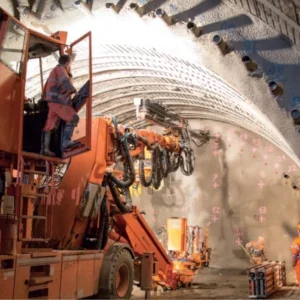Requirements in shotcrete are; adhesion to the rock, quick set, early strength, long-term strength, and high durability. As the wet-mix process is popular nowadays, there is also a need to keep fresh shotcrete in a workable state for an appropriate time before the shotcrete operation commences. During the operation, low dust and low rebound of shotcrete is also required.
Requirements of shotcrete with high strength at an early age, such as compressive strength of several MPa after minutes, first arose from the need to increase the speed of excavation. Application of high early strength shotcrete can decrease the required thickness of the shotcrete layer, and can decrease the operation period. Also, high early strength shotcrete can enhance rock support and in some cases, reduce or eliminate the need for steel ribs.
Setting of steel ribs at the working face of the tunnel is one of the more dangerous operations, and thus a decrease or elimination of the need for steel ribs increases safety in tunnel construction. Enhancement of rock support by use of high early strength shotcrete is effective, especially in fractured zones with faults and swelling ground. Application of high early strength shotcrete in such conditions can decrease the displacement of rock and keep the excavation from converging. Consequently, application of high early strength shotcrete can decrease the total costs of tunnel construction.
Formation of Ettringite
The chemical formula for Ettringite is 3CaO-Al2O3-3CaSO4- 32H2O, and one molecule of Ettringite contains 32 water molecules, which is about 46% of Ettringite by weight. Ettringite usually forms in a needle-like structure.
In the field of cement chemistry and concrete engineering, Ettringite is called a “cement bacillus” or poisonous material, which can destroy the concrete structure if it develops at the wrong time during the cement hydration reaction. Destruction of a concrete microstructure is caused by the formation of Ettringite during the latest stages of hydration, which is called “Delayed Ettringite Formation”. Formation of Ettringite at the latest stages of cement hydration can produce cracks from the interior of the concrete microstructure.
On the other hand, improvement of concrete performance at early ages is achieved by controlling the formation of Ettringite (Ishida, 2000[1]). Quick setting, quick hardening, high strength, and expansion or shrinkage compensation is achieved by controlling the period of Ettringite formation during the cement hydration reactions. For example, quick setting of cement or concrete is achieved by the formation of Ettringite at the very first stage of cement hydration. Usually, accelerators based on calcium-aluminate or calcium-sulfo-aluminate are used for quick setting of cement and concrete (Ishida, 2001[2]). For quick set and high strength at an early age, calcium-aluminate based accelerator and calcium-sulfate based powder additive are applied to produce Ettringite at a very early age.
Composition
Table 1 provides a guideline for the composition of high early strength shotcrete compared with other shotcrete types.
Design strength: In Japan, the design basis strength for “Normal shotcrete” is 18MPa after 28 days, and this specification is used in road tunnels, railway tunnels and power plant tunnels, etc. “High strength shotcrete” is mainly used in highway road tunnels with large cross sections, and its design basis strength is 36MPa after 28 days. For high early strength shotcrete, several tunnel projects used the desired strength of over 2MPa after 10 minutes, or sometimes 3MPa after 10 minutes.
Cement: Normal Portland cement is generally used for the shotcretes listed in Table 1. Cement content for the high early strength shotcrete is from 400 to 500kg/m3, while that for Normal shotcrete is 360kg/m3 and for High Strength shotcrete is 450kg/m3. Blended cements, such as Portland blast-furnace slag cement and Portland fly-ash cement, have disadvantages in strength development at early ages, and are not normally considered suitable for such shotcrete.
Water to cement ratio: A standard water to cement ratio for Normal shotcrete is 60%. As low water to cement ratio is preferred for high strength and for quick setting, standard water to cement ratio of High Strength shotcrete is 45%. For high early strength shotcrete, a water to cement ratio of less than 50% is preferred and the use of super-plasticizer is recommended in some cases.
Additive and admixture: For Normal shotcrete, neither additive nor admixture is used. For High Strength shotcrete, super-plasticizer is used to decrease the water to cement ratio and to keep suitable workability of fresh concrete.
High early strength shotcrete requires “High strength additive”, in order to achieve strength development at very early ages. Table 2 shows the property of high strength additive. High strength additive is calcium-sulfate based powder and proper content is from 7 to 12% by mass of cement. In case of composition with cement content of 400kg/m3, the additive content is recommended to be from 28 to 48kg/m3.
Other additives such as silica-fume, fly-ash, and blast-furnace slag can be used in some cases, in order to increase the densification of the concrete structure and achieve high strength and high durability.
Accelerators: As a powder type accelerator is used in most shotcrete applications in Japan, a specification for powder accelerator is listed in Table 1. Each of the shotcrete types has a suitable accelerator and suitable additive content. Table 3 shows the list of powder accelerators based on calcium-aluminate.
Powder based accelerators are added to wet-mix shotcrete with an air conveyance system, using the supply device similar to rotary system equipment. The accelerators are conveyed with air, and are mixed with wet concrete at the point of Y-shape pipe forward to the nozzle.
In order to achieve sufficient rock support in both hard ground and soft-and-wet ground, powder accelerator based on calcium aluminate has been widely used in Japan (Teramura, 1993[3] and Hirose, 1993[4]). As calcium-aluminate is a cement-like material and has self-hardening properties, it shows better performance such as quick setting and high early strength compared with other powder accelerators or liquid accelerators. Accordingly, it has advantages in application to ground with complicated geological formations and spring waters, which is common in Japan.
An accelerator for Normal shotcrete is calcium-aluminate based powder, with additive content from 5 to 10% by mass of cement. Calcium-sulfo-aluminate based powder accelerator is used for High Strength shotcrete with additive content from 8 to 15% by mass of cement. For high early strength shotcrete, another type of calcium-aluminate based powder accelerator is used together with calcium-sulfate based high strength additive. A proper content of the accelerator is from 7 to 15% by mass of cement. Calcium-sulfate based high strength additive is added to the concrete with a same content of accelerator.
Other conditions: Sand to aggregates ratio (s/a) is usually around 60% depending on the quality of aggregates. The maximum size of the coarse aggregate is usually 13mm or 10mm. Appropriate values of concrete slump differ with the different types of shotcrete, and generally the slump of the Normal shotcrete is lower than for the other two shotcrete types.
Characteristics of high strength additive and accelerator
Evaluation of the additive and accelerator for high early strength shotcrete was carried out by measuring quick setting and strength development of mortar. Table 4 shows the condition of mortar composition. The cement to sand ratio is based on the cement content in concrete, which is 23.6% for a cement content of 380kg/m3, 25.4% for 400kg/m3, and 27.4% for 430kg/m3. Three sets of additive contents and accelerator content were chosen, and added in the same amount into the base mortar. Accelerator was added to the fresh mortar and mixed for 15 seconds in a mixer, and then immediately molded in a specified case. The evaluation was carried out at 20°C.
Quick setting: Quick setting of mortar is conducted by measuring the proctor penetration resistance in accordance with ASTM C-403. The time of initial setting (3.5MPa of resistance) and final setting (28MPa of resistance) were measured, and all of the mortar samples resulted in final setting times of less than 45 seconds after adding the accelerator.
Strength development: Compressive strength of mortar is measured by preparing test pieces of 40 x 40 x 160mm, and setting 400 x 400mm attachments to the test piece, which is in accordance with JIS R 5201. The test piece was first kept in a 20°C and 80% relative humidity condition, and then cured in water after one day.
Figure 1 shows the relationship between water to binder ratio and compressive strength after 10 minutes, and Figure 2 shows the relation between accelerator content and compressive strength after 10 minutes. Both water to binder ratio and accelerator content have a strong correlation with compressive strength after 10 minutes. High compressive strength is obtained by a low water to binder ratio and high accelerator content. This relationship is achieved to the age of 1 day.
Figure 3 and Figure 4 shows the same relationship at the age of 7 days. The water to binder ratio still has a strong correlation with compressive strength, but the accelerator content does not have a good correlation with compressive strength after 7 days. A similar relationship is also observed after 28 days, with increase of compressive strength of about 10MPa. The compressive strength of mortar with cement content of 430kg/m3 and with accelerator and high strength additive content of both 10% by mass of cement was over 75MPa.
Evaluation
Shotcrete evaluation was carried out in a model tunnel 4.5m high, 5.5m wide and 20m long. Wet-mix method was chosen, and a piston type concrete pump with maximum capacity of 25m3/hr was used in the experiments. A powder accelerator supply device (NATM-crete) similar to the rotary type concrete supply equipment, such as Aliva was used.
Table 5 shows the materials used in the experiment, Table 6 the composition of the shotcrete as batched. High early strength shotcrete (HE) was evaluated with comparison to Normal shotcrete (N) and High Strength shotcrete (H).
Table 7 shows the results of strength from early ages to 28 days. Strengths before 1 day were measured by a pull-out method (JSCE-G 561-2005[5]), and strengths after 7 days were measured on 55mm diameter and 110mm long cores (JIS A 1107, JIS R 5201[7]). The compressive strength of base concrete was measured on 100mm diameter X 200mm long cylinders.
Early Strength: Early strength of 4MPa after 10 minutes was achieved in high early strength shotcrete. The strength increased with the age and reached nearly 20MPa after 1 day. High Strength shotcrete resulted in 1.7MPa after 1 hour and 2.5MPa after 3 hours, which is less than half, compared with high early strength shotcrete. Compared with High Strength shotcrete, Normal shotcrete results in similar strength after 3 hours but low strength after 1 day (about half of the strength of high early strength shotcrete)
Long Term Strength: Comparing the compressive strength after 28 days, high early strength shotcrete had nearly 60MPa after 28 days, which is about double that of Normal shotcrete. High Strength shotcrete also resulted in a high compressive strength of about 50MPa after 28 days.
Application
Several tunnel projects have used high early strength shotcrete. The Sanno tunnel for the Japan Highway Corporation in Niigata prefecture is one of the first tunnels to use shotcrete with high early strength (Tanase, 1998[8, 9]). The desired strength of the shotcrete was set to 2MPa after 10 minutes.
The Mineyama tunnel, which is also located in Niigata prefecture, of Japan Railway Corporation applied an advanced type of the shotcrete with a desired strength of 3MPa after 10 minutes, using silica-fume and other additives, compared with the one applied in the Sanno tunnel (Ikoma, 2002[10] & Ochi, 2003[11]). These two tunnels were constructed in relatively soft ground with less displacement of ground. High early strength shotcrete was applied to decrease the required thickness of the shotcrete layer, increase the excavation speed and decrease the total cost of tunnel construction.
In the case of the Iiyama tunnel of Japan Railway Corporation, also in Niigata prefecture, high early strength shotcrete was applied to fractured zones with faults and swelling ground, and resulted in an effective decrease of displacement of ground and support of the ground after excavation (Nakamura, 2004[12]). Synthetic fibre of modified polyolefin with 1 vol% of concrete was used in the shotcrete.
Conclusions
Shotcrete with high early strength, over 2MPa at an age of 10 minutes, has advantages in enhancement of rock support, improvement of safety, increase of excavation speed, and decrease of total cost in tunnelling.
High early strength shotcrete is achieved by applying calcium-aluminate based powder accelerator and calcium-sulfate based powder additive. The calcium-aluminate based powder accelerator is hydro-reactive and has self-hardening properties on reacting with water. Ettringite is observed by reaction of the accelerator and calcium-sulfate based powder additive, together with cement and water.
Shotcrete experiments in a model tunnel resulted in very high strength from early to later ages, 4MPa after 10 minutes, about 20MPa after 1 day, and nearly 60MPa after 28 days. From some applications of high early strength shotcrete in several tunnel projects, it was demonstrated that it can decrease the thickness of shotcrete layer, eliminate the need for steel ribs, shorten the excavation period, and decrease the total tunnelling cost.
Acknowledgments
This article has been reproduced from “Shotcrete for Underground Support X”, Whistler, Canada, September 2006, ©ASCE. All rights reserved. To purchase a copy of the proceedings please visit: www.pubs.asce.org
Water to binder ratio and compressive strength after 10 mins Figure 1 – Water to binder ratio and compressive strength after 10 mins Figure 2 – Accelerator content and compressive strength after 10 mins Water to binder ratio and compressive strength after 7 days Figure 3 – Water to binder ratio and compressive strength after 7 days Accelerator content and compressive strength after 7 days Figure 4 – Accelerator content and compressive strength after 7 days Table 1. Guideline for shotcrete composition Table 2. Property of high strength additive Table 4. Composition of mortar for evaluation of high early strength additive and accelerator Table 3. List of calcium-aluminate based powder type accelerators used in Japan Table 5. Material used in shotcrete experiment Table 6. Composition of shotcrete Table 7. Compressive strength of shotcrete (MPa)





